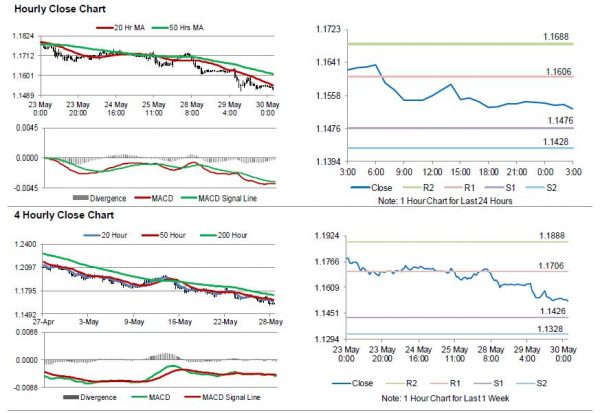For the 24 hours to 23:00 GMT, the EUR rose 1.07% against the USD and closed at 1.1664, as renewed efforts to form a coalition government in Italy reduced fears of an early election.
On the economic front, data showed that the Euro-zone’s final consumer confidence index eased as initially estimated to a level of 0.2 in May, after recording a revised level of 0.3 in the previous month.
Separately, Germany’s flash consumer price index (CPI) advanced more-than-estimated by 2.2% on an annual basis in May, rising by the most since February 2017, amid a surge in energy prices. Market participants had expected the CPI to rise 1.9%, after registering a gain of 1.6% in the previous month. Moreover, the nation’s seasonally adjusted unemployment rate surprisingly fell to 5.2% in May, thus boosting optimism over the health of the nation’s labour market. Unemployment rate had registered a reading of 5.3% in the prior month, while markets had expected for a steady reading.
Separately, the Organisation for Economic Cooperation and Development (OECD), in its biannual economic outlook, forecasted that economic growth in the Euro-zone would hit 2.2% this year and 2.1% in 2019. Additionally, the organisation estimated that global economy would expand by 3.8% this year and by 3.9% in 2019, up from an initial forecast of 3.7% and 3.6% respectively, amid a rebound in global trade and a favourable fiscal policy. However, it also warned that prospects of a global trade war pose significant risks to global growth outlook.
The US Dollar declined against a basket of major currencies, after second estimate of the US annualised gross domestic product (GDP) was revised lower to 2.2% on a quarterly basis in the first three months of 2018, while the preliminary print had indicated a rise of 2.3%. The GDP had recorded an advance of 2.9% in the previous quarter.
In other economic news, the nation’s advance goods trade deficit narrowed to $68.2 billion in April, dropping to its lowest level in 6 months. The nation had registered a revised trade deficit of $68.6 billion in the prior month, while market participants had envisaged the deficit to widen to $71.0 billion. On the other hand, the nation’s ADP private sector employment climbed by 178.0K in May, undershooting market expectations for a rise of 190.0K. Private sector employment had registered a revised gain of 163.0K in the prior month.
Separately, according to the Federal Reserve’s (Fed) Beige Book report, the US economy expanded moderately from late April to early May. Further, it revealed that most districts reported a pickup in manufacturing activity. However, concerns over the Trump administration’s trade policies clouded the business outlook.
In the Asian session, at GMT0300, the pair is trading at 1.1662, with the EUR trading slightly lower against the USD from yesterday’s close.
The pair is expected to find support at 1.1562, and a fall through could take it to the next support level of 1.1462. The pair is expected to find its first resistance at 1.1719, and a rise through could take it to the next resistance level of 1.1776.
Moving ahead, traders would focus on the Euro-zone’s flash inflation figures for May and unemployment rate data for April, slated to release in a few hours. Later today, the US initial jobless claims, followed by pending home sales, personal income and spending data, all for April, will garner significant amount of market attention.
The currency pair is trading above its 20 Hr and 50 Hr moving averages.













